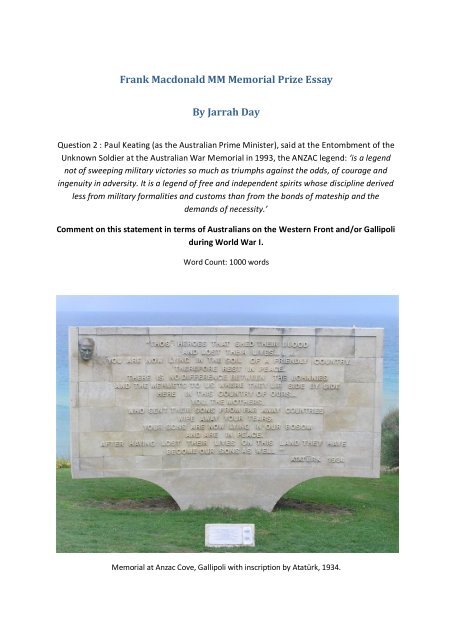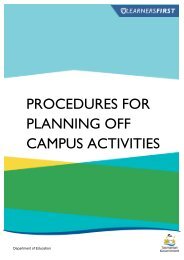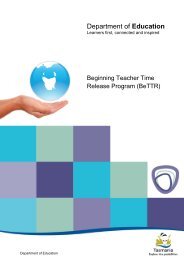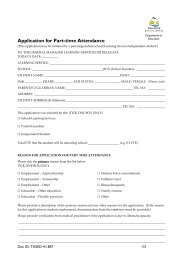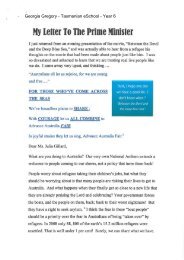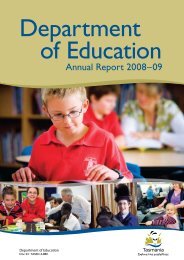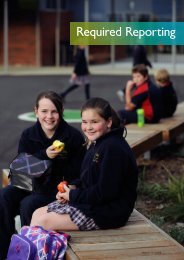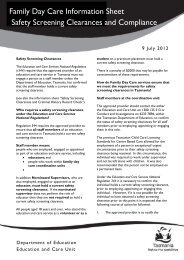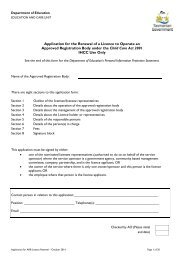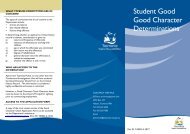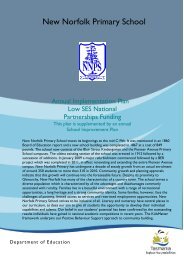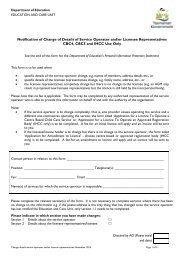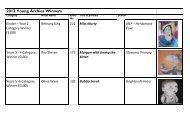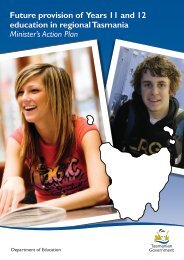Frank Macdonald MM Memorial Prize Essay By Jarrah Day
Frank Macdonald MM Memorial Prize Essay By Jarrah Day
Frank Macdonald MM Memorial Prize Essay By Jarrah Day
You also want an ePaper? Increase the reach of your titles
YUMPU automatically turns print PDFs into web optimized ePapers that Google loves.
<strong>Frank</strong> <strong>Macdonald</strong> <strong>MM</strong> <strong>Memorial</strong> <strong>Prize</strong> <strong>Essay</strong><br />
<strong>By</strong> <strong>Jarrah</strong> <strong>Day</strong><br />
Question 2 : Paul Keating (as the Australian Prime Minister), said at the Entombment of the<br />
Unknown Soldier at the Australian War <strong>Memorial</strong> in 1993, the ANZAC legend: ‘is a legend<br />
not of sweeping military victories so much as triumphs against the odds, of courage and<br />
ingenuity in adversity. It is a legend of free and independent spirits whose discipline derived<br />
less from military formalities and customs than from the bonds of mateship and the<br />
demands of necessity.’<br />
Comment on this statement in terms of Australians on the Western Front and/or Gallipoli<br />
during World War I.<br />
Word Count: 1000 words<br />
<strong>Memorial</strong> at Anzac Cove, Gallipoli with inscription by Atatürk, 1934.
<strong>Jarrah</strong> <strong>Day</strong><br />
Year 9, Taroona High School, Taroona<br />
During the Great War, the ANZACs earned legendary respect for their actions, so great, that even<br />
now, nearly one hundred years later, their legacy continues. The Tomb of the Unknown Soldier is a<br />
tomb of commemoration, to honour and represent all ANZACs. Though we know neither his name<br />
nor rank, nor his personal information, we know that he was amongst the 45,000 Australians who<br />
died during the Great War. 1 Although this tomb was proposed in the 1920s, it was not constructed<br />
until 1993. 2 During the funeral service of the Unknown Australian Soldier, Prime Minister Paul<br />
Keating spoke of the soldiers that formed the ANZAC legend, of their courage and ingenuity in the<br />
face of adversity, their free and independent spirit and the strong bonds of mateship. Paul Keating’s<br />
speech described key points of the ANZACs identity and qualities that make Australians proud of<br />
them. Not only were they courageous, but the respect they gave those who fought in the war, both<br />
with them and against them, has lived on through time and remains part of the ANZAC legend.<br />
There are many ways that the ANZACs at Gallipoli triumphed against the odds and many lives were<br />
saved through their courage and ingenuity. My great-great-uncle Fred Tomlins joined the 1 st Light<br />
Horse Regiment and embarked on the HMAT Star of Victoria in October 1914. 3 During his service in<br />
the Great War, Fred went to Egypt, Gallipoli and Palestine, keeping a diary of his experiences. 4 He<br />
wrote on the 20 th of December 1915 “It was previously estimated that 2000 men would be lost in<br />
the evacuation and we got away scot free.” The remarkable achievement of their evacuation<br />
without casualties was due to their ingenuity and the invention of self firing rifles by William Charles<br />
Scurry. The rifles used the change in weight as water flowed between quart pots 5 to keep them firing<br />
long after the troops had evacuated 6 . Private A.E. Edwards, a signaller at Gallipoli, wrote about this<br />
invention’s success, “We were taken off to a small transport, from which the Turks could be heard<br />
still firing at nothing.” 7<br />
As well as triumphing against the odds, the ANZAC legend is of free spirits whose discipline is derived<br />
less from military formalities and customs than from the bonds of mateship and necessity. This<br />
sentiment is strong in the stories that my grandmother Margaret <strong>Day</strong> was told as a little girl by her<br />
parents who both served in the Great War. She recalls “One aspect of the Australian troops was that<br />
they hated the formality of many British officers, who insisted on being saluted and such like. They<br />
were happier (mostly) with Australian officers.” 8 If anything, the ANZACs detested the formalities<br />
that others tried to force upon them. Perhaps they preferred Australian officers because their typical<br />
lack of military training allowed a less formal structure and closer bonds between the soldiers and<br />
the officers.<br />
1 Remembrance <strong>Day</strong> Speech delivered by the Prime Minister, The Hon. P. J. Keating MP, at the funeral service of the<br />
Unknown Australian Soldier, 11 th November 1993.<br />
2 The Unknown Soldier, by Australian War <strong>Memorial</strong>s, http://www.awm.gov.au/commemoration/customs/soldier.asp<br />
[accessed 15 th August 2012]<br />
3 First World War Embarkation Roll – Fred Harold Tomlins. Australian War <strong>Memorial</strong><br />
http://www.awm.gov.au/research/people/nominal_rolls/first_world_war_embarkation/person.asp?p=303598 [Accessed<br />
20 th August 2012]<br />
4 Rae, Ruth (2012). The Price of Peace: The diaries of Fred Tomlins, First Australian Light Horse, World War One. (Kindle<br />
Locations 2440-2441). Ruth Rae Consultancies. Kindle Edition. Fred Tomlins was the brother of my great grandmother,<br />
Jessie Tomlins, a trained nurse in the 14 th Australian General Hospital, Australian Army Nursing Service, in Egypt.<br />
5 See appendix 4 for a photo of my great-grandfather’s quart pot.<br />
6<br />
Lincoln, Merrilyn, 'Scurry, William Charles (1895–1963)', Australian Dictionary of Biography, National Centre of Biography,<br />
Australian National University, http://adb.anu.edu.au/biography/scurry-william-charles-8376/text14701, accessed 22 nd<br />
August 2012.<br />
7 Page 429 “Gallipoli” by Peter Hart, *accessed through Google books.]<br />
8 Email from Margaret <strong>Day</strong> OAM 17 th August 2012 subject World War 1<br />
2
<strong>Jarrah</strong> <strong>Day</strong><br />
Year 9, Taroona High School, Taroona<br />
The close friendship bonds between the ANZAC soldiers are obvious. 9 This was expressed in a letter<br />
to Idonia Kentish regarding the death of her brother, Reginald Stow Kentish, “Stow's death was a<br />
great loss to 16 Platoon. The boys of 16 wish me to send their sympathies and that they cherish the<br />
memory of a brave and manly lad.” 10 As this letter shows, the strong bonds and closeness between<br />
the soldiers meant they looked out for each other, enabling many to survive against the odds.<br />
One of the strongest aspects of the ANZAC legend is the respect that many soldiers held for the<br />
Turks. This has remained through the years and may be the most important part of the ANZAC<br />
legend. Fred Tomlins wrote on the 24 th of May 1915 “The Australians and Turks have been changing<br />
coins, cigarettes and biscuits this afternoon and been having friendly yarns while shifting dead<br />
Turks.” 11 These interactions show that the soldiers understand the effect of their enemy losing<br />
comrades which suggests a uniquely powerful respect between enemy forces. This connection<br />
continued and Fred Tomlins wrote on the 21 st of December 1915, “Most of the lads [ANZAC soldiers]<br />
left notes behind thanking Abdul for the use of the ground … also for the fair fight they had given us,<br />
also assuring them that any food left behind has not been poisoned but is quite good.” 12 To show<br />
such respect towards enemy troops during war is remarkable. This is an aspect of the ANZAC legend<br />
to be proud of and one that continues to be expressed through time. In 1992, the respect that the<br />
ANZACs had earned through their actions was demonstrated to my mother in Austria. Upon hearing<br />
her Australian accent, the Turkish shopkeeper said “Australia? Bang bang bang, Gallipoli!” thrust<br />
drinks into her hands and embraced her. 13 This act of kindness and friendship was remarkable, as<br />
they had never met, and neither of them had fought in the war. The ANZACs’ actions during the war<br />
must have been so gallant and had such profound impacts that even the people they fought against<br />
showed them great respect. The inscription on the Anzac Cove <strong>Memorial</strong> contains Atatürk’s heartfelt<br />
words to the mothers of the dead, to rest assured that their sons are in peace and are equal<br />
brothers with the Turks who lie there. 14<br />
Few events impact a nation in a way that changes not only the current generation but also<br />
generations to come. The bonds of mateship, the respect shown to others, and the actions of the<br />
soldiers who fought at Gallipoli and the Western Front influenced people in such a way that it is still<br />
talked about nearly one hundred years later. The people who did this were not necessarily the<br />
officers nor the politicians, but the ordinary soldiers. They are the Unknown Soldier. As Paul Keating<br />
said, the Unknown Soldier is “all of them, and he is one of us.” Their actions have, in many ways<br />
shaped the Australian identity and the respect they earned has left a legacy that continues to be<br />
passed down through the generations and across nationalities.<br />
9 Speech at the Entombment of the Unknown Soldier by Paul Keating, diaries of Fred Tomlins, and communication with<br />
Margaret <strong>Day</strong>.<br />
10 Letter to Idonia Kentish from Captain <strong>Frank</strong>s concerning the matter of the death of Reginald Stow Kentish, 48 th Battalion,<br />
Australian Infantry, AIF, a cousin of my great grandfather, Hugh Spencer Kentish, 3 rd Regiment, 1 st Australian Light Horse<br />
Brigade, AIF.<br />
11 Entry on 24 th May 1915 Rae, Ruth (2012). The Price of Peace: The diaries of Fred Tomlins, First Australian Light Horse,<br />
World War One. (Kindle Locations 2440-2441). Ruth Rae Consultancies. Kindle Edition.<br />
12 Entry from 21 st December 1915. Rae, Ruth (2012). The Price of Peace: The diaries of Fred Tomlins, First Australian Light<br />
Horse, World War One. (Kindle Locations 2440-2441). Ruth Rae Consultancies. Kindle Edition.<br />
13 Verbal communication with Louise Emmerson, who at the time was travelling through Europe as a young 22 year old<br />
backpacker. Since this interaction at the shop in Austria she has actively increased her understanding of Gallipoli and the<br />
Australian-Turkish interactions.<br />
14 The inscription on the memorial at Anzac Cove, Gallipoli quoting a message from Mustafa Kemal Atatürk to the first<br />
visitors who had come from Australia, New Zealand and England in 1934.<br />
3
<strong>Jarrah</strong> <strong>Day</strong><br />
Year 9, Taroona High School, Taroona<br />
Appendices<br />
Appendix 1: My great-grandfather Hugh<br />
Spencer Kentish just arrived home from war in<br />
1919, in his 3 rd Regiment, 1 st Light Horse<br />
uniform.<br />
Appendix 2: My great-grandfather’s quart pot.<br />
Appendix 3: Australian Imperial Force Nominal Roll. Contains details about my great-great-uncle<br />
Fred Tomlins.<br />
4
Annotated Bibliography<br />
Primary Sources: Published<br />
Extract of Nominal Roll of Australian Imperial Force who left Australia for service abroad, 1914-1918 War.<br />
Available at http://www.awm.gov.au/collection/records/awm8/10/6/awm8-10-6-1-0223.pdf [Accessed 20 th<br />
August 2012] (Record of Fred Tomlins’ embarkation.)<br />
Hart, Peter (2011). Gallipoli. Profile Books(GB). (This contains a quote by Private A. E. Edwards, 2 nd Divisional<br />
Signal Company, 2 nd Division, AIF, on the evacuation of Gallipoli.)<br />
Rae, Ruth (2012). The Price of Peace: The diaries of Fred Tomlins, First Australian Light Horse, World War One.<br />
(Kindle Locations 2440-2441). Ruth Rae Consultancies. Kindle Edition. (This contains the complete diaries of my<br />
great-great-uncle Fred Harold Tomlins. It contains numerous personal accounts on many events during the<br />
Great War.)<br />
User:Romtobbi (2005). “Monument to Atatürk” http://en.wikiquote.org/wiki/File:Attaturkswords5.jpg<br />
[Accessed 4 th of September 2012] (A photo of the memorial at Anzac Cove, Gallipoli quoting a message from<br />
Mustafa Kemal Atatürk to the first visitors who had come from Australia, New Zealand and England in 1934.<br />
Also used for cover photo. Photograph released into public domain by uploader.)<br />
Primary Sources: Unpublished<br />
<strong>Day</strong>, Margaret OAM, 17 th August, 2012, First World War, (email from mday@picknowl.com.au to<br />
jarrah.day@gmail.com). (Margaret is my grandmother, daughter of Hugh Spencer Kentish and Jessie Millicent<br />
Kentish (nee Tomlins). Very useful because it gave ideas for sources, information about my relatives, various<br />
diaries and letters and stories that had been passed down from her parents.)<br />
<strong>Day</strong>, Margaret OAM, 15 th August, 2010, really true stories, (email from mday@picknowl.com.au to<br />
jarrah.day@gmail.com). (Contained transcript of letter to Idonia Kentish, and various stories about my greatgrandparents.)<br />
Captain <strong>Frank</strong>s (1918). Letter to Idonia Kentish about her brother’s death. (Family papers held by Margaret<br />
<strong>Day</strong>. This letter shows how close the bonds between soldiers were.)<br />
Emmerson, Louise (2012). Interview about her experiences backpacking in Austria during 1992. (An example of<br />
how the respect the ANZACs earned continues through the generations.)<br />
Kentish, Hugh Spencer (1917). Diary extracts from the Battle of Beersheba.<br />
Tomlins, Jessie Millicent (1916-1918). Letters to her mother during the Great War. (Information about what<br />
was happening during the war, and ideas about the care the Australians had for each other.)<br />
Secondary Sources: Internet<br />
Lincoln, Merrilyn, 'Scurry, William Charles (1895–1963)', Australian Dictionary of Biography, National Centre of<br />
Biography, Australian National University, http://adb.anu.edu.au/biography/scurry-william-charles-<br />
8376/text14701, [Accessed 22 nd August 2012] (Had information about the self firing rifle invented by William<br />
Scurry.)<br />
The Unknown Soldier, Australian War <strong>Memorial</strong>s,<br />
http://www.awm.gov.au/commemoration/customs/soldier.asp [Accessed 15 th August 2012] (Contains<br />
information about the Entombment of the Unknown Australian Soldier War <strong>Memorial</strong>.)


